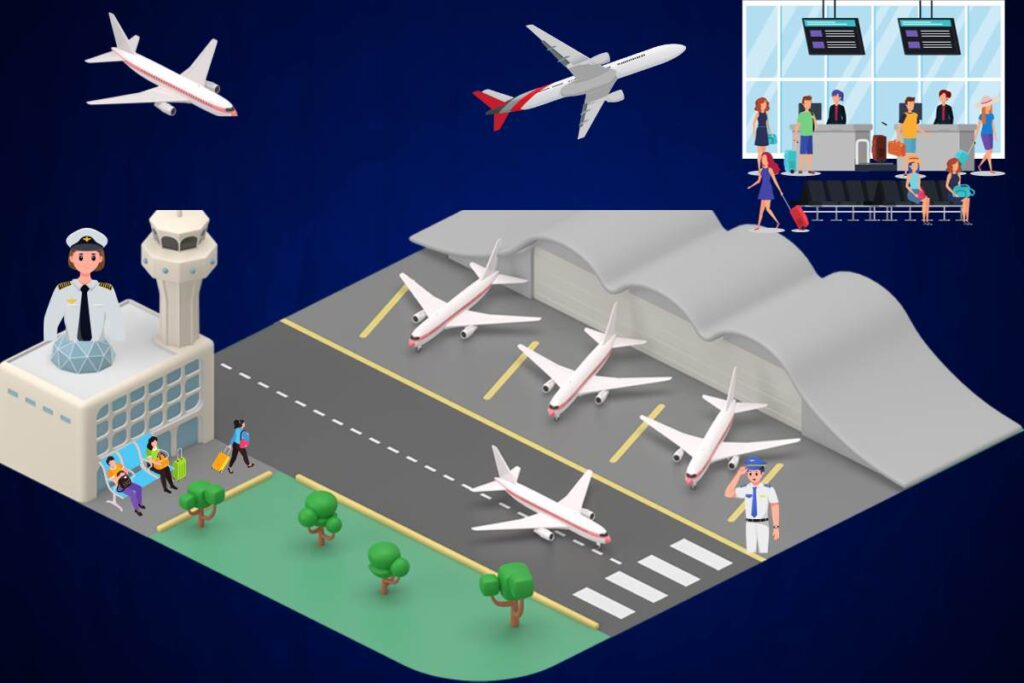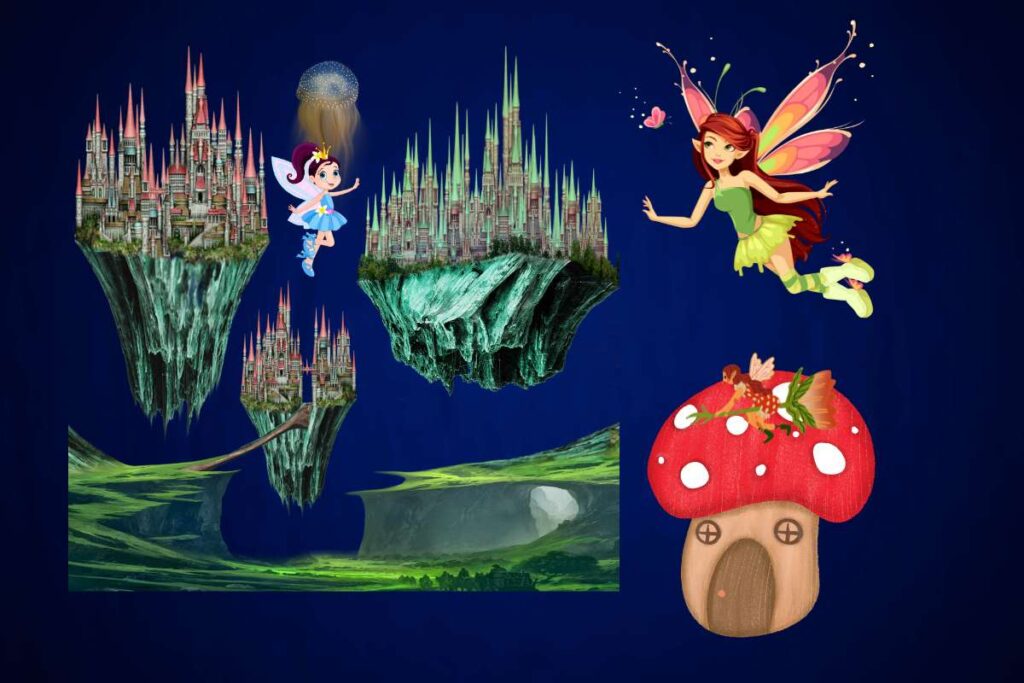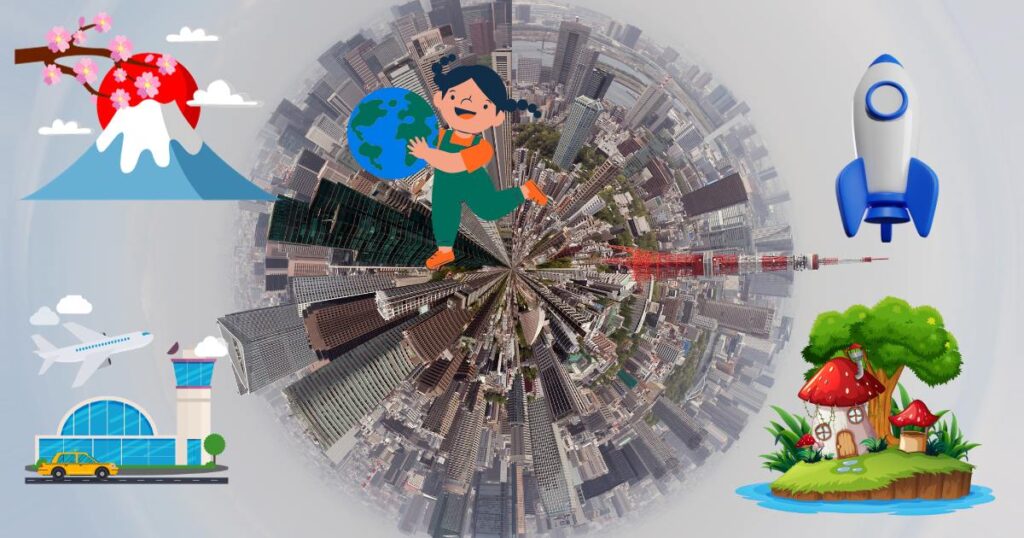Small Worlds Tokyo is an indoor miniature theme park in Tokyo, Japan. It is one of the world’s largest indoor miniature theme parks, covering approximately 8,000 square meters. The park showcases intricately detailed miniature replicas of various scenes, including cities, airports, and space stations. These miniatures are crafted with an astonishing level of detail and precision.
Table of Contents
What’s Small World Tokyo?
Situated in Koto Ward, Tokyo, Small Worlds Tokyo is a unique indoor theme park that brings miniature worlds to life. Using advanced tech like robotics and projection mapping, the park offers several themed zones that capture your imagination.
Visitors can watch airplanes take off and land in the detailed Airport Zone or explore famous global landmarks in the Global Village. For space enthusiasts, the Space Center features mini rockets and a space station.
There’s even a Kansai Japanese Area that showcases the rich culture of Japan’s Kansai region. From kids to adults, everyone will find something fascinating here. It’s like stepping into different corners of the world and beyond, all without leaving Tokyo.
The park is divided into multiple zones, such as:
1)Airport Zone 2)Global Village 3)Space Center 4)Kansai Japanese Area 5)Fantasy Zone
1. Airport Zone:
It is a miniature airport that features planes taking off and landing, complete with realistic sounds and lighting.
The ‘Airport Zone’ is one of the key areas within Small Worlds Tokyo. This zone features an impressively detailed, scaled-down replica of an airport.
The meticulousness of the model captures everything from planes taxiing, taking off, and landing to the internal workings of the terminal buildings. It’s a blend of craftsmanship and technology that offers a captivating experience for aviation enthusiasts and general visitors alike.

What to See at Airport Zone?
1. Scaled Airplanes: You’ll see various types of aircraft, both commercial and private, that are precisely modeled. Some of them even move along the tarmac and runways.
2. Control Tower: The control tower is also a focal point, overseeing the entire operations of the miniature airport.
3. Ground Operations: Pay attention to the vehicles like baggage carts, fuel trucks, and other service equipment that you would find in a real airport. They also move around, adding to the realism.
4. Terminal Building: The terminal is intricately designed with details that go as far as waiting areas, check-in desks, and shops.
5. Lighting and Sound Effects: The zone employs sophisticated lighting and sound effects to simulate different times of the day and various weather conditions, adding to the overall immersive experience.
6. Dynamic Changes: The Airport Zone usually features a day-to-night transition, often accompanied by changes in lighting to mimic the natural progression of a day, which makes the experience more captivating.
7. Information Boards: Often, there are info boards or displays that provide interesting facts about aviation, the particular models used, or the real-life counterparts of the miniatures.
8. Runway: Watch miniature planes actually take off and land on the runway, complete with lighting and sound effects.
9. Hangars and Maintenance Areas: Some models include hangars and maintenance areas where planes are being ‘repaired,’ adding another layer of realism to the setup.
The Airport Zone in Small Worlds Tokyo offers a rich, interactive experience that combines art, technology, and a love for aviation into a compelling visual spectacle. Whether you’re an aviation enthusiast or simply interested in detailed miniatures, this zone offers something.
2. Global Village:
This area usually consists of miniature representations of various world cities like London, Tokyo, and others.
The ‘Global Village’ is another fascinating zone within Small Worlds Tokyo.
This area aims to showcase miniature replicas of famous cities and landmarks from around the world. The meticulous attention to detail and advanced technology make the Global Village a mesmerizing experience for visitors.

What to See at Global Village?
1. Iconic Cities: Expect to see miniature versions of major global cities like Tokyo, London, Paris, and New York, each capturing the essence and landmarks of the respective locations.
2. Famous Landmarks: Look out for iconic structures like the Eiffel Tower, Big Ben, or Tokyo Tower, painstakingly recreated to scale.
3. Cultural Highlights: The area often includes cultural events, festivals, or parades depicted in miniature form, like a cherry blossom festival in Japan or a Mardi Gras parade.
4. Vehicles and People: Small Worlds Tokyo doesn’t just focus on buildings; you’ll also see miniature cars, buses, and people moving around these cities, offering a dynamic element to the scenes.
5. Day-Night Cycle: Much like other zones in the park, Global Village usually features a day-to-night cycle, using lighting effects to simulate the transition, adding to the realism.
6. Natural Elements: Some setups incorporate natural features like rivers, parks, and forests that provide a contrasting backdrop to urban landscapes.
7. Interactive Elements: Some installations may allow you to interact with the scene by pressing a button to initiate a certain action, like a train moving or lights coming on.
8. Narrative Boards or Audio Guides: Information boards or audio guides are often available that provide interesting facts about the cities and landmarks being depicted to enhance the educational aspect.
9. Fine Details: The artistry often extends to tiny details like street signs, billboards, and even the interiors of certain buildings, viewable through windows.
10. Seasonal or Thematic Updates: Depending on the time of year or current events, the Global Village might feature special installations or updates, so there’s often something new to see.
The Global Village in Small Worlds Tokyo offers a thrilling journey through the world’s renowned cities and landmarks without leaving Tokyo. It’s an enthralling experience for those interested in world cultures, architecture, and the art of miniature crafting.
3. Space Center:
Here, you can see a miniature space station and rocket launch site.
The ‘Space Center’ is one of the specialized zones within Small Worlds Tokyo that captivates visitors interested in space exploration and science fiction. This zone aims to give you an up-close look at the intricacies of space exploration, albeit in a scaled-down version.
It generally features spacecraft, launch pads, and even space stations.

What to See at Space Center?
1. Rocket Launch: One of the highlights of the Space Center is the detailed depiction of a rocket launch pad and often an actual “launch” sequence, complete with lighting and sound effects.
2. Space Station: Expect to see a miniature space station model that showcases the exterior and interior with extraordinary detail.
3. Astronaut Figures: The zone usually includes scaled-down astronaut figures performing various tasks, such as conducting experiments or spacewalks, adding to the realism.
4. Control Room: Look out for a miniaturized version of a mission control room, where you might see “technicians” monitoring the various activities related to a space mission.
5. Vehicles and Modules: You might encounter different types of vehicles and modules used in space exploration, like lunar rovers or satellites, rendered in great detail.
6. Celestial Bodies: Some versions might include miniatures or representations of celestial bodies like planets, moons, or asteroids.
7. Advanced Technology: The zone uses sophisticated technology like projection mapping, IoT, and robotics to make the miniatures interactive and lifelike.
8. Educational Information: Alongside the displays, there may be placards or information boards detailing various facts about space exploration, the history of space missions, or the science behind it.
9. Sound and Lighting Effects: Expect immersive soundscapes and lighting effects that add to the realism, sometimes even simulating the void of space or the surface of a celestial body.
10. Interactive Elements: Depending on the design, you may be able to initiate actions through buttons or touch panels, like launching a rocket or activating certain lights.
11. Sci-fi Collaboration: Sometimes, Small Worlds Tokyo collaborates with popular science fiction franchises to bring fictional spacecraft or planets to life in miniature form.
The Space Center is a unique blend of education and entertainment, capturing the imagination of both children and adults. Whether you’re a space enthusiast or just intrigued by the final frontier, the Space Center zone at Small Worlds Tokyo provides a captivating experience.
4. Kansai Japanese Area:
This zone focuses on traditional and modern Japanese culture, featuring scenes like cherry blossom festivals and temples.
The ‘Kansai Japanese Area’ within Small Worlds Tokyo is dedicated to showcasing various aspects of Japanese culture, history, and modern life, focusing on the Kansai region. The Kansai region is known for its rich cultural heritage, including historical cities like Kyoto and Osaka, and this zone aims to bring that to life in miniature form.

What to See at Kansai Zone?
1. Traditional Architecture: You can expect to see miniature versions of iconic traditional Japanese buildings like temples, shrines, and homes.
2. Natural Scenery: Japanese gardens, complete with miniature ponds, bonsai trees, and cherry blossoms, may be included to capture the beauty of Japanese nature.
3. Festivals: Miniature scenes depicting famous festivals like Gion Matsuri or Tanabata might be displayed, capturing the vibrancy and traditions of Kansai culture.
4. Modern and Traditional Blend: The zone often blends modern elements like skyscrapers and busy city streets with traditional architecture, signifying the seamless blend of the old and new in Kansai.
5. Historical Sites: Expect to see scaled-down versions of famous landmarks and historical sites like Kyoto’s Kinkaku-ji (Golden Pavilion) or Osaka Castle.
6. Local Cuisine: Some versions of the Kansai Japanese Area also feature miniature food stalls or markets that offer local Kansai delicacies like takoyaki and okonomiyaki.
7. Day-to-Night Cycle: Similar to other zones, the Kansai Japanese Area usually incorporates dynamic lighting to simulate the day-to-night transition, adding to the realism.
8. Transportation: Look for detailed replicas of public transportation systems, including trains and buses, characteristic of the Kansai region.
9. People and Daily Life: Expect to see miniature figures engaged in a variety of activities, from participating in tea ceremonies to shopping in a bustling marketplace.
10. Seasonal Changes: Depending on the time of the year, the area might change to reflect the season, like cherry blossoms in spring or colorful leaves in autumn.
11. Interactive Features: Some installations may have buttons that allow you to interact with the scene, such as turning on lights or starting a festival parade.
The Kansai Japanese Area within Small Worlds Tokyo serves as an educational and entertaining glimpse into the Kansai region’s rich culture, history, and modern life. Whether you’re a fan of traditional Japanese culture or curious about the different aspects of life in Japan, this zone offers a fulfilling experience.
5. Fantasy Zone:
As the name suggests, this zone takes you to fantastical worlds, sometimes featuring collaborations with various popular franchises.
The ‘Fantasy Zone’ in Small Worlds Tokyo is a creative playground where imagination takes center stage. Unlike the other zones that aim for realism, this area delves into fantasy, science fiction, and sometimes even collaborations with popular franchises.
It’s a place where the usual rules of physics and history may not apply, allowing for a truly unique visitor experience.

What to See at Fantasy Zone?
1. Fantasy Landscapes: You’ll likely encounter mystical forests, magical castles, or even otherworldly planets designed with meticulous attention to detail.
2. Creatures and Characters: From dragons to wizards to iconic characters from various franchises, the Fantasy Zone brings an array of imaginative figures to life.
3. Storybook Scenes: Some setups may recreate famous scenes from fantasy literature or movies, allowing you to see them in a new, miniaturized form.
4. Interactive Quests: Depending on the current installations, you might find interactive elements that allow you to go on miniature quests or solve puzzles.
5. Collaborations: This zone is often the site for special collaborations with popular media franchises, whether they be from the realm of fantasy, science fiction, or even anime.
6. Special Effects: Expect state-of-the-art technology like projection mapping, advanced animatronics, and dynamic lighting to create a fully immersive experience.
7. Fantasy Vehicles: From flying ships to steampunk contraptions, the Fantasy Zone often features various forms of imaginative transportation.
8. Day-Night Cycle: Like the other zones, the Fantasy Zone usually incorporates a day-to-night lighting cycle to simulate the passage of time in these fantastical worlds.
9. Magical Elements: Watch for special magical effects, like glowing mystical artifacts or spellcasting sequences, often enhanced with lighting and sound effects.
10. Narrative Elements: Storylines or quests might be integrated into the displays, sometimes complete with written or audio guides that help deepen your understanding and immersion.
11. Exclusive Merchandise: The Fantasy Zone might sometimes offer special merchandise related to the current theme or collaboration, which can be a unique keepsake from your visit.
The Fantasy Zone is designed to captivate your imagination and offer a departure from the real world, providing a unique experience within Small Worlds Tokyo. Whether you’re a fantasy fan or just someone looking to explore the boundaries of imagination, this zone offers an array of sights and experiences that will enchant you.
The theme park incorporates advanced technology like IoT, robotics, and projection mapping to make the miniatures as dynamic and realistic as possible. For instance, the lighting in the zones changes to simulate the passage from day to night.
Overall, Small Worlds Tokyo is a fascinating blend of craftsmanship and technology, offering a unique experience for visitors interested in miniature art and models.
Opening hours: 9:00-19:00
Admission fee:
- Adult (18 years or older): 2,700 yen
- Chuunin (12-17 years old): 1,900 yen
- Dwarf (4-11 years old): 1,500 yen
- Under 3 years old: Free
Where to buy online Tickets?
You can buy tickets on the spot the day you visit but remember that it’s a very famous spot in Tokyo and often gets crowded.
So you may have to wait for a long time in the long queue. People usually buy online tickets before they go there.
For an effortless and unforgettable experience at Small Worlds Tokyo, look no further than Klook, one of the most reputable travel platforms.
With glowing reviews to back its credibility, Klook offers a seamless ticket-buying process, often at exclusive prices and bundled deals you won’t find anywhere else.
Don’t miss out on exploring the intricate miniature worlds of airports, global landmarks, and space stations in the heart of Tokyo. Buy Advance Tickets now to secure your ticket and elevate your travel experience with the reliability and convenience only Klook can offer.
How to access it?
There are multiple transportation options available to access Small Worlds Tokyo, as per the information you’ve provided:
By Train:
a) Yurikamome Line: The closest station is the ‘Ariake Tennis no Mori Station.’ It’s a 3-minute walk from this station to Small Worlds Tokyo.
b) Rinkai Line: If you are coming via the Rinkai Line, you will need to get off at the ‘Kokusai Tenjijo Station.’ From there, it’s a 9-minute walk to the attraction.
By Bus:
a) Miyako Bus: You can take the Higashi 16 or Miyako 05-2 bus routes and alight at the ‘Ariake Tennis Forest’ stop. From there, it’s a 3-minute walk.
b) By Limousine Bus:
Haneda Airport Line: If you are coming from Haneda Airport, you can take the Limousine bus that goes to ‘Ariake Garden.’ Once you arrive, it’s a 10-minute walk to Small Worlds Tokyo.
By BRT:
TOKYO BRT International Exhibition Center: If you are near the Ariake Tennis Forest, it’s a 3-minute walk to the TOKYO BRT International Exhibition Center.
Address:
Ariake Logistics Center, 1-3-33 Ariake, Koto-ku, Tokyo 135-0063
Official website:
